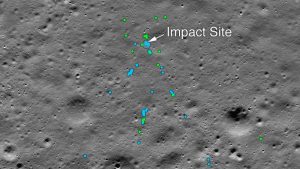A Chennai-based engineer has been credited by NASA for alerting them about the presence of the debris of the lander of Chandrayaan 2, India’s ambitious moon mission. Shanmuga Subramanian, 33, found the debris from the Vikram moon lander that scientists had been looking for and helped guide them to the spot where it had crashed.
Indian Space Research Organisation (ISRO) had lost contact with the Vikram lander following its launch from Chandraayan 2 moon orbiter on September 6 when it tried to make soft-landing near the moon’s south pole.
The US space agency made the announcement today, releasing an image taken by its Lunar Reconnaissance Orbiter (LRO) that showed the site of the spacecraft’s impact (September 6 in India and September 7 in the US).
“The wreck first determined by Shanmuga is approximately 750 meters northwest of the foremost crash position and was a unique bright pixel description in that first mosaic,” NASA said in a statement.
The lander had lost contact shortly before the scheduled attempt to soft-land on the moon on September 7. Days after the failed landing, ISRO said it had located the lander but hadn’t been able to establish communication.

NASA said it released a mosaic image of the site on September 26 (but taken on September 17), inviting the public to compare it with images of the same area before the crash to find signs of the lander.
Mr. Subramaniam was the first person to come up with identification. He said NASA’s inability to find the lander on its own had sparked his interest.
“I had a side-by-side comparison of those two images on two of my laptops… on one side there was the old image, and another side there was the new image published by NASA,” he reported news bureau.
“It was quite hard, but (I) spent some effort,” said the self-professed space nerd, finally announcing his discovery on Twitter on October 3.
NASA then performed additional searches in the area and officially announced the finding almost two months later.
“I worked hard tracking the intended path of Vikram lander,” Mr. Subramanian told the news agency. “I am excited. It was a lot of hard work. I’ve always had a passion for space science. I would never miss a launch,” the space enthusiast said.
A top NASA scientist said Mr. Subramanian’s work was completely independent. “The story of this amazing individual (who) found it, helped us find it, is awesome,” NASA’s Noah Petro told news agency IANS.
He said that Subramanian “is independent of the LRO, totally independent of the Chandraayan 2 team, just someone who is very interested in the Chandraayan 2 mission (who) used our data and identified a spot where there was a change that we had not identified”.
“He went through the image, looking pixel by pixel and found that spot,” Mr. Petro added.
India had assumed to produce space antiquity amidst the Rs. 1,000-crore Chandrayaan 2 mission.

